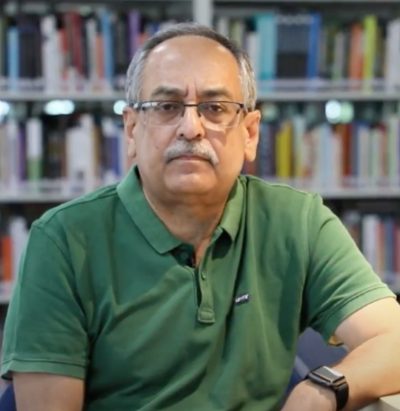Privacy and Security in large public service applications
Governments around the world – and India in particular – are trying to build large data registries for effective delivery of a variety of public services. However, these efforts are often undermined due to serious concerns over privacy risks associated with collection and processing of personally identifiable information. While a rich set of special- purpose privacy-preserving techniques exist in computer science, they are unable to provide end-to-end protection in alignment with legal principles in the absence of an overarching operational architecture to ensure purpose limitation and protection against insider attacks. This either leads to weak privacy protection in large designs, or adoption of overly defensive strategies to protect privacy by compromising on utility.
We investigate the issues in designing an operational architecture for privacy-by-design based on independent regulatory oversight stipulated by most data protection regimes, regulated access control, purpose limitation and data minimisation.
- Traceable mixnets. Prashant Agrawal, Abhinav Nakarmi, Mahavir Prasad Jhawar, Subodh Sharma, Subhashis Banerjee. Privacy Enhancing Technology Symposium (PoPETs/PETS), July 2024. (https://arxiv.org/abs/2305.08138).
- On health data architecture design. Prashant Agrawal, Subodh Sharma, Ambuj Sagar, Subhashis Banerjee. Book chapter in Private and controversial: When public health and privacy meet in India. Edited by Smriti Parsheera. Harper Collins. January, 2023. (https://www.cse.iitd.ac.in/~suban/reports/ndhm2.pdf)
- Elements of an accountability-based framework for privacy protection. Prashant Agrawal, Anubhutie Singh, Malavika Raghavan, Subodh Sharma, Subhashis Banerjee. 2021. (working paper)
- An operational architecture for privacy-by-design in large public service applications. Prashant Agrawal, Subodh Sharma, Subhashis Banerjee. 2020 (working paper)
- Privacy concerns with Aadhaar. Subhashis Banerjee, Subodh Sharma. Commun. ACM 62(11): 80, 2019.
- Privacy and Security of Aadhaar: A Computer Science Perspective. Shweta Agrawal, Subhashis Banerjee and Subodh Sharma. Economic and Political Weekly, September 2017.
Electronic voting
India’s parliamentary election is the largest in the world, with 543 constituencies and well over 1 million voters per constituency on the average, and voting is conducted electronically since 2004. However, there is considerable doubt about the integrity of both the Electronic Voting Machine (EVM) used by the Election Commission of India (ECI) and the procedure for maintaining and updating voters lists.
We analyse the ECI solutions from the points of view of verifiability and compliance with democratic principles. We also investigate a) the possibility of end-to-end verifiable electronic voting that can support voter-verified paper audit trails in a closely coupled manner, and b) the issues with security, integrity and privacy of electoral rolls.
- Publicly auditable privacy-preserving electoral rolls. Prashant Agrawal, Mahabir Prasad Jhanwar, Subodh Sharma, Subhashis Banerjee. IEEE Computer Security Foundations. July, 2024. (https://arxiv.org/abs/2402.11582)
- OpenVoting: Recoverability from failures in dual voting. Prashant Agrawal, Kabir Tomer, Abhinav Nakarmi, Mahabir Prasad Jhanwar, Subodh Sharma, Subhashis Banerjee. E- Vote-ID – The International Conference for Electronic Voting, Luxembourg City, October 2023. (https://arxiv.org/abs/1908.09557).
- Traceable mixnets. Prashant Agrawal, Abhinav Nakarmi, Mahavir Prasad Jhawar, Subodh Sharma, Subhashis Banerjee. Privacy Enhancing Technology Symposium (PoPETs/PETS), July 2024. (https://arxiv.org/abs/2305.08138).
- Citizens’ Commission on Elections’ Report on EVMs and VVPAT. Madan Lokur, Wajahat Habibullah, Hariparanthaman, Arun Kumar, Subhashis Banerjee, Pamela Philipose, John Dayal, Sundar Burra and M. G. Devasahayam. Economic and Political Weekly, Vol. 57, Issue No. 3, 15 Jan, 2022. (https://www.epw.in/journal/2022/3/perspectives/citizens%E2%80%99-commission-elections%E2%80%99-report-evms-and.html)
- Blockchain vs public bulletin boards for integrity of elections and electoral rolls. Prashant Agrawal, Subodh Sharma, Subhashis Banerjee. The India Forum, August, 2021. (theindiaforum.in/…/blockchain-vs-public-bulletin-board-integrity-elections-and-electoral-rolls)
Computational radiology
In collaboration with the radiology group at AIIMS, New Delhi, we investigate improved detection of breast cancer from mammograms in situations where the presentation is obscure and difficult. We also investigate using other auxiliary information to improve the accuracy of detection.
In a one-off problem, we also addressed detection of Covid from chest X-Ray in a hospital setting.
- Reproducibility and Explainability of Deep Learning in Mammography: A Systematic Review of Literature. Deeksha Bhalla, Krithika Rangarajan, Tany Chandra, Subhashis Banerjee, Chetan Arora. The Indian Journal of Radiology and Imaging. October 2023. (10.1055/s-0043-1775737)
- Deep learning for detection of iso-dense, obscure masses in mammographically dense breasts. Krithika Rangarajan, P Aggarwal, D K Gupta, Rohan Dhanakshirur, Akhil Baby, Chandan Paul, A K Gupta, Smriti Hari, Subhashis Banerjee, Chetan Arora. European Radiology. June 2023. (https://doi.org/10.1007/s00330-023-09717-7)
- Building and evaluating an artificial intelligence algorithm: A practical guide for practicing oncologists. Anupama Ramachandran, Deeksha Bhalla, Krithika Rangarajan, Raja Pramanik, Subhashis Banerjee, Chetan Arora. Artif Intell Cancer. Jul 28, 2022; 3(3): 42-53. (https://doi.org/10.35713/aic.v3.i3.42)
- Ultra-high resolution, multi-scale, context-aware approach for small cancers on Mammography. Krithika Rangarajan, Aman Gupta, Saptarshi Dasgupta, Uday Marri, Arun Kumar Gupta, Smriti Hari, Subhashis Banerjee, Chetan Arora. Scientific Reports 12, 11622 (2022). (https://doi.org/10.1038/s41598-022-15259-7)
- Basic principles of AI simplified for a Medical Practitioner: Pearls and Pitfalls in Evaluating AI algorithms. Deeksha Bhalla, Anupama Ramachandran, Krithika Rangarajan, Rohan Dhanakshirur, Subhashis Banerjee, Chetan Arora. Current Problems in Diagnostic Radiology, 2022. ISSN 0363-0188. (https://doi.org/10.1067/j.cpradiol.2022.04.003)
- Multi-modal cancer detection on mammography using patient history and multiple view. Krithika Rangarajan, Rohan Dhanakshirur, Arun Gupta ( AIIMS), Smita Manshanda, Subhashis Banerjee, Chetan Arora. 2021 (working paper)
- Artificial Intelligence-Assisted Chest X-Ray Assessment Scheme for COVID-19. Krithika Rangarajan, Sumanyu Muku, Amit Kumar Garg, Pavan Gabra, Sujay Halkur Shankar, Neeraj Nischal, Kapil Dev Dev Soni, Ashu Seith Bhalla Seith Bhalla, Anant Mohan, Pawan Tiwari, Sushma Bhatnagar, Raghav Bansal, Atin Kumar, Shivanand Gamanagati, Richa Aggarwal, Upendra Baitha, Ashutosh Biswas, Arvind Kumar, Pankaj Jorwal, . Shalimar, A Shariff, Naveet Wig, Rajeshwari Subramanium, Anjan Trikha, Rajesh Malhotra, Randeep Guleria, Vinay Namboodiri, Subhashis Banerjee, Chetan Arora. European Radiology. January 2021. (pubmed.ncbi.nlm.nih.gov/33471219)
- Simulation Training for Diagnostic Radiology: Use of GAN Generated Images for Resident Training in Mammography. Sneha Goswami, Ambikapathi P, Suransh Chopra, Vishwas Lathi, Krithika Rangarajan, Surabhi Vyas, Smriti Hari, Arun Gupta, Vinay Namboodiri, Subhashis Banerjee, Chetan Arora. RSNA 2020.
Neurosurgery simulation
We have an ongoing collaboration with AIIMS where we study and build simulators for neuroendoscopy skills training.
- From Forks to Forceps: A New Framework for Instance Segmentation of Surgical Instruments. Britty Baby, Daksh Thapar, Mustafa Chasmai, Tamajit Banerjee, Kunal Dargan, Ashish Suri, Subhashis Banerjee, Chetan Arora. IEEE/CVF Winter Conference on Applications of Computer Vision (WACV), 2023. (https://www.computer.org/csdl/proceedings-article/wacv/2023/934600g180/1KxUiPGe7eM)
- Representation Learning using Rank Loss for Robust Neurosurgical Skills Evaluation. Britty Baby, Mustafa Chasmai, Tamajit Banerjee, Ashish Suri, Subhashis Banerjee, Chetan Arora. International Conference on Image Processing (ICIP), October 2022. (https://ieeexplore.ieee.org/document/9897932)
- A Review of Physical Simulators for Neuroendoscopy Skills Training. Britty Baby, Ramandeep Singh, Rajdeep Singh, Ashish Suri, Chetan Arora, Subodh Kumar, Prem Kumar Kalra, Subhashis Banerjee. World Neurosurgery, 137:398-407, May 2020.
- A review of virtual reality simulators for neuroendoscopy. Britty Baby, Ramandeep Singh, Ashish Suri, Rohan Raju Dhanakshirur, Argha Chakraborty, Subodh Kumar, Prem Kumar Kalra, Subhashis Banerjee. Neurosurgical Review, Volume 43, pages 1255-1272, 2020.
Predicting development indicators using satellite imagery
We develop a set of machine learning based tools for accurate prediction of socio-economic indicators from daytime satellite imagery. The diverse set of indicators are often not intuitively related to observable features in satellite images, and are not even always well correlated with each other. Our predictive tool is more accurate than using night light as a proxy, and can be used to predict missing data, smooth out noise in surveys, monitor development progress of a region, and flag potential anomalies
- Using satellites and artificial intelligence to measure health and material-living standards in India. Adel Daoud, Felipe Jordan, Makkunda Sharma, Sourabh Bikash Paul, Fredrik Johansson, Devdatt Dubhashi, Subhashis Banerjee.. Social Indicators Research. April 29, 2023. (https://doi.org/10.1007/s11205-023-03112-x)
- On monitoring development indicators using high resolution satellite images. Potnuru Kishen Suraj, Ankesh Gupta, Makkunda Sharma, Sourabh Bikas Paul, Subhashis Banerjee, December 2017. ()
On large-scale 3D reconstruction
We look at large scale (city scale) 3D reconstruction from image collections.
Simultaneous Localisation and Mapping (SLAM) and Ego-motion
We briefly looked at some problems related to self-driving cars, in particular that of monocular SLAM and ego-motion.
- Batch based Monocular SLAM for Egocentric Videos. Suvam Patra, Kartikeya Gupta, Faran Ahmad, Chetan Arora, Subhashis Banerjee. IEEE Winter Conference on Applications of Computer Vision (WACV), March 2019. (https://arxiv.org/abs/1707.05564)
- A Joint 3D-2D based method for free space detection on roads. Suvam Patra, Pranjal Maheshwari, Shashank Yadav, Chetan Arora, Subhashis Banerjee. IEEE Winter Conference on Applications of Computer Vision (WACV), March 2018. (https://arxiv.org/abs/1711.02144,)
- Deep CNN with Color Lines model for unmarked road segmentation. Shashank Yadav, Suvam Patra, Chetan Arora, Subhashis Banerjee. IEEE International Conference on Image Processing (ICIP 2017), Beijing, September 2017 (ieeexplore.ieee.org/document/8296348)
- Computing Egomotion with Local Loop Closures for Egocentric Videos. Suvam Patra, Himanshu Aggarwal, Himani Arora, Chetan Arora, Subhashis Banerjee. IEEE Winter Conference on Applications of Computer Vision (WACV), March 2017
On reliability of machine learning
We investigate reliability issues of machine learning, especially with respect to adversarial attacks.
REGroup: Rank-aggregating Ensemble of Generative Classifiers for Robust Predictions. Lokender Tiwari, Anish Madan, Saket Anand, Subhashis Banerjee. IEEE/CVF Winter Conference on Applications of Computer Vision (WACV), 2022. (https://openaccess.thecvf.com/content/WACV2022/papers/Tiwari_REGroup_Rank-Aggregating_Ensemble_of_Generative_Classifiers_for_Robust_Predictions_WACV_2022_paper.pdf)








